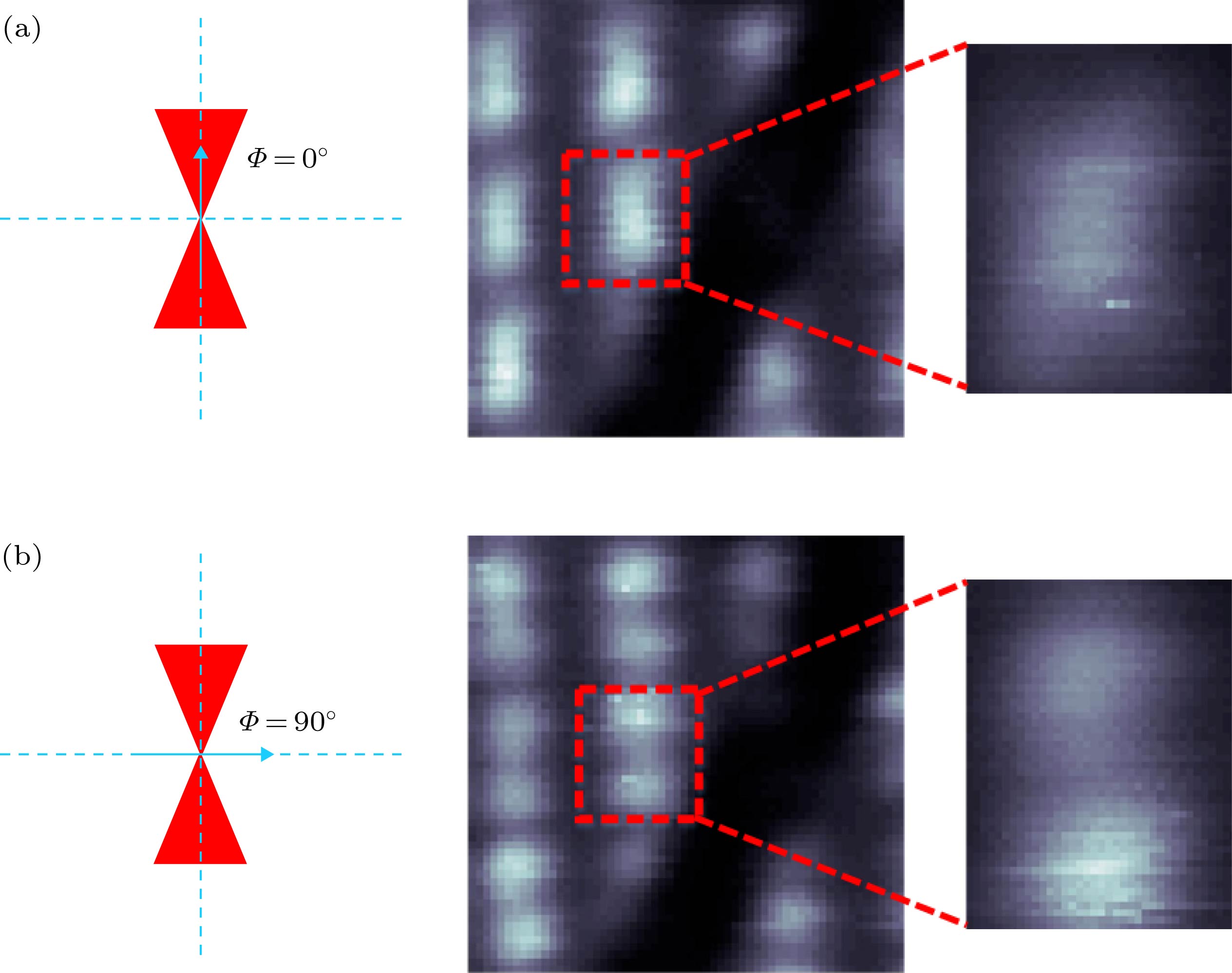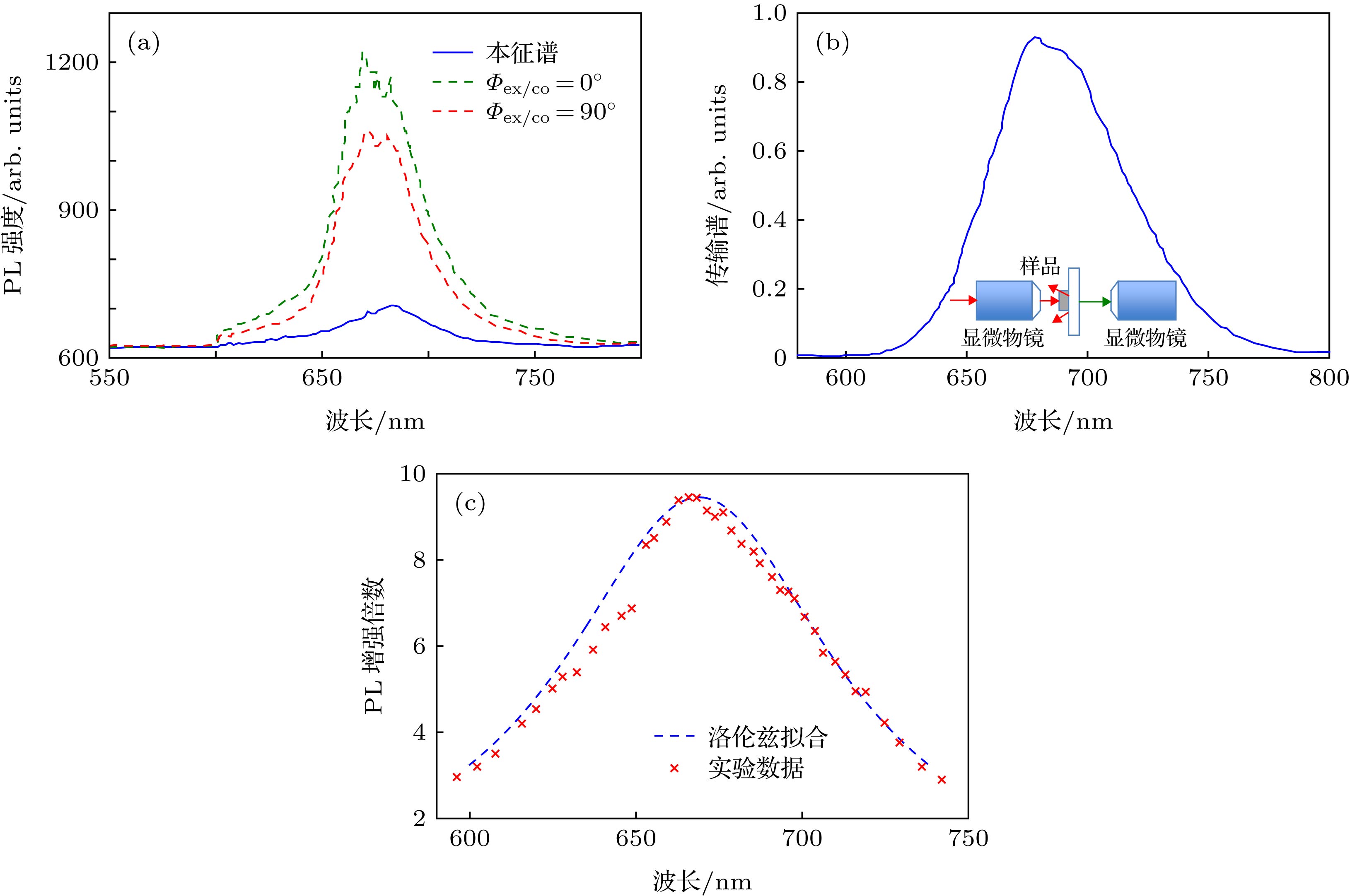-
二硫化钼(MoS2)作为一种层状过渡金属硫族化合物, 是未来光子学与光电子学领域的重要组成材料. 本文设计实现了MoS2与谐振腔耦合系统, 将蝴蝶结型等离子体谐振腔的谐振模式与单层MoS2光致发光(PL)谱相耦合, 得到该条件下最佳PL强度增强效果. 通过理论模型与实验数据的分析, 利用珀塞尔效应对自发辐射速率进行控制, 得到了峰值为9.5倍、带宽为100 nm的宽带增强谱. 同时, 增强的PL强度随激发光和探测光的偏振角度满足余弦函数规律的依赖特性, 证明了谐振模式来自谐振腔中的电场偶极子. 该研究提供了在单层MoS2与等离子体谐振腔耦合结构中研究光与物质相互作用增强的可行性, 为今后基于MoS2光子学器件的发射与探测效率提升开辟出一条新途径.Molybdenum disulfide (MoS2), as a layered transition metal chalcogenide, plays an important role in fields of photonics and photoelectronics. Here, a coupled system consisting of monlayer MoS2 and nano-resonator is designed and implemented. The photoluminescence (PL) spectrum of the MoS2 is coupled with the resonant mode of plasmonic bowtie resonator, thus achieving an optimal PL enhancement condition. Based on the analysis of theoretical model and experimental data, the spontaneous emission rate can be controlled by the Purcell effect, and the broadband enhanced spectrum is obtained in which its peak value increases 9.5 times and bandwidth is 100 nm . Meanwhile, the enhanced PL intensity also satisfies the cosine function relation between the polarization angle of the exciting light and that of the detecting light, which proves that the resonance mode comes from the electric field dipole in the resonator. This study provides the feasibility of studying the enhancement of light-matter interaction in an MoS2-plasmonic resonator coupled structure, which opens up a new route to improving the emission and detection efficiency of MoS2-based photonic devices in future.
-
Keywords:
- MoS2 /
- photoluminescence /
- plasmonic resonator /
- Purcell effect
[1] Wang C C, Liu X S, Wang Z Y, Zhao M, He H, Zou J Y 2018 Chin. Phys. B 27 118106
 Google Scholar
Google Scholar
[2] Wang Q H, Kalantar-Zadeh K, Kis A, Coleman J N, Strano M S 2012 Nature Nanotech. 7 699
 Google Scholar
Google Scholar
[3] Li X, He D W, Wang Y S, Hu Y, Zhao X, Fu C, Wu J Y 2018 Chin. Phys. B 27 056104
 Google Scholar
Google Scholar
[4] 董海明 2013 物理学报 62 206101
 Google Scholar
Google Scholar
Dong H M 2013 Acta Phys. Sin. 62 206101
 Google Scholar
Google Scholar
[5] Huang X, Zeng Z, Zhang H 2013 Chem. Soc. Rev. 42 1934
 Google Scholar
Google Scholar
[6] Chhowalla M, Shin H S, Eda G, Li L J, Loh K P, Zhang H 2013 Nature Chem. 5 263
 Google Scholar
Google Scholar
[7] 顾品超, 张楷亮, 冯玉林, 王芳, 苗银萍, 韩叶梅, 张韩霞 2016 物理学报 65 018102
 Google Scholar
Google Scholar
Gu P C, Zhang K L, Feng Y L, Wang F, Miao Y P, Han Y M, Zhang H X 2016 Acta Phys. Sin. 65 018102
 Google Scholar
Google Scholar
[8] 魏晓旭, 程英, 霍达, 张宇涵, 王军转, 胡勇, 施毅 2014 物理学报 63 217802
 Google Scholar
Google Scholar
Wei X X, Cheng Y, Huo D, Zhang Y H, Wang J Z, Hu Y, Chi Y 2014 Acta Phys. Sin. 63 217802
 Google Scholar
Google Scholar
[9] Mak K F, Lee C, Hone J, Shan J, Heinz T F 2010 Phys. Rev. Lett. 105 136805
 Google Scholar
Google Scholar
[10] Splendiani A, Sun L, Zhang Y, Li T, Kim J, Chim C Y, Galli G, Wang F 2010 Nano Lett. 10 1271
 Google Scholar
Google Scholar
[11] Lopez-Sanchez O, Lembke D, Kayci M, Radenovic A, Kis A 2013 Nature Nanotech. 8 497
 Google Scholar
Google Scholar
[12] Sundaram R S, Engel M, Lombardo A, Krupke R, Ferrari A C, Avouris P, Steiner M 2013 Nano Lett. 13 1416
 Google Scholar
Google Scholar
[13] Wang K P, Wang J, Fan J T, Lotya M, O’Neill A, Fox D, Feng Y Y, Zhang X Y, Jiang B X, Zhao Q Z, Zhang H Z, Coleman J N, Zhang L, Blau W J 2013 ACS Nano 7 9260
 Google Scholar
Google Scholar
[14] Emmanuel F, Samuel G 2008 J. Phys. D: Appl. Phys. 41 013001
 Google Scholar
Google Scholar
[15] Gan X T, Gao Y D, Mak K F, Yao X W, Shiue R J, Zande A, Trusheim M, Hatami F, Heinz T, Hone J, Englund D 2013 Appl. Phys. Lett. 103 181119
 Google Scholar
Google Scholar
[16] Wu S F, Buckley S, Jones A M, Ross J S, Ghimire N J, Yan J Q, Mandrus D G, Yao W, Hatami F, Vuckovic J, Majumdar A, Xu X D 2014 2D Mater. 1 011001
[17] Kinkhabwala A, Yu Z F, Fan S H, Avlasevich Y, Mullen K, Moerner W E 2009 Nature Photon. 3 654
 Google Scholar
Google Scholar
[18] Guo R, Kinzel E C, Li Y, Uppuluri S M, Raman A, Xu X F 2010 Opt. Express 18 4961
 Google Scholar
Google Scholar
[19] Tongay S, Fan W, Kang J, Park J, Koldemir U, Suh J, Narang D S, Liu K, Ji J, Li J B, Sinclair R, Wu J Q 2014 Nano Lett. 14 3185
 Google Scholar
Google Scholar
[20] Lu G W, Li W Q, Zhang T Y, Yue S, Liu J, Hou L, Li Z, Gong Q H 2012 ACS Nano 6 1438
 Google Scholar
Google Scholar
-
-
[1] Wang C C, Liu X S, Wang Z Y, Zhao M, He H, Zou J Y 2018 Chin. Phys. B 27 118106
 Google Scholar
Google Scholar
[2] Wang Q H, Kalantar-Zadeh K, Kis A, Coleman J N, Strano M S 2012 Nature Nanotech. 7 699
 Google Scholar
Google Scholar
[3] Li X, He D W, Wang Y S, Hu Y, Zhao X, Fu C, Wu J Y 2018 Chin. Phys. B 27 056104
 Google Scholar
Google Scholar
[4] 董海明 2013 物理学报 62 206101
 Google Scholar
Google Scholar
Dong H M 2013 Acta Phys. Sin. 62 206101
 Google Scholar
Google Scholar
[5] Huang X, Zeng Z, Zhang H 2013 Chem. Soc. Rev. 42 1934
 Google Scholar
Google Scholar
[6] Chhowalla M, Shin H S, Eda G, Li L J, Loh K P, Zhang H 2013 Nature Chem. 5 263
 Google Scholar
Google Scholar
[7] 顾品超, 张楷亮, 冯玉林, 王芳, 苗银萍, 韩叶梅, 张韩霞 2016 物理学报 65 018102
 Google Scholar
Google Scholar
Gu P C, Zhang K L, Feng Y L, Wang F, Miao Y P, Han Y M, Zhang H X 2016 Acta Phys. Sin. 65 018102
 Google Scholar
Google Scholar
[8] 魏晓旭, 程英, 霍达, 张宇涵, 王军转, 胡勇, 施毅 2014 物理学报 63 217802
 Google Scholar
Google Scholar
Wei X X, Cheng Y, Huo D, Zhang Y H, Wang J Z, Hu Y, Chi Y 2014 Acta Phys. Sin. 63 217802
 Google Scholar
Google Scholar
[9] Mak K F, Lee C, Hone J, Shan J, Heinz T F 2010 Phys. Rev. Lett. 105 136805
 Google Scholar
Google Scholar
[10] Splendiani A, Sun L, Zhang Y, Li T, Kim J, Chim C Y, Galli G, Wang F 2010 Nano Lett. 10 1271
 Google Scholar
Google Scholar
[11] Lopez-Sanchez O, Lembke D, Kayci M, Radenovic A, Kis A 2013 Nature Nanotech. 8 497
 Google Scholar
Google Scholar
[12] Sundaram R S, Engel M, Lombardo A, Krupke R, Ferrari A C, Avouris P, Steiner M 2013 Nano Lett. 13 1416
 Google Scholar
Google Scholar
[13] Wang K P, Wang J, Fan J T, Lotya M, O’Neill A, Fox D, Feng Y Y, Zhang X Y, Jiang B X, Zhao Q Z, Zhang H Z, Coleman J N, Zhang L, Blau W J 2013 ACS Nano 7 9260
 Google Scholar
Google Scholar
[14] Emmanuel F, Samuel G 2008 J. Phys. D: Appl. Phys. 41 013001
 Google Scholar
Google Scholar
[15] Gan X T, Gao Y D, Mak K F, Yao X W, Shiue R J, Zande A, Trusheim M, Hatami F, Heinz T, Hone J, Englund D 2013 Appl. Phys. Lett. 103 181119
 Google Scholar
Google Scholar
[16] Wu S F, Buckley S, Jones A M, Ross J S, Ghimire N J, Yan J Q, Mandrus D G, Yao W, Hatami F, Vuckovic J, Majumdar A, Xu X D 2014 2D Mater. 1 011001
[17] Kinkhabwala A, Yu Z F, Fan S H, Avlasevich Y, Mullen K, Moerner W E 2009 Nature Photon. 3 654
 Google Scholar
Google Scholar
[18] Guo R, Kinzel E C, Li Y, Uppuluri S M, Raman A, Xu X F 2010 Opt. Express 18 4961
 Google Scholar
Google Scholar
[19] Tongay S, Fan W, Kang J, Park J, Koldemir U, Suh J, Narang D S, Liu K, Ji J, Li J B, Sinclair R, Wu J Q 2014 Nano Lett. 14 3185
 Google Scholar
Google Scholar
[20] Lu G W, Li W Q, Zhang T Y, Yue S, Liu J, Hou L, Li Z, Gong Q H 2012 ACS Nano 6 1438
 Google Scholar
Google Scholar
计量
- 文章访问数: 11002
- PDF下载量: 120
- 被引次数: 0














 下载:
下载:




